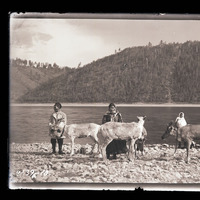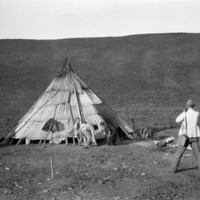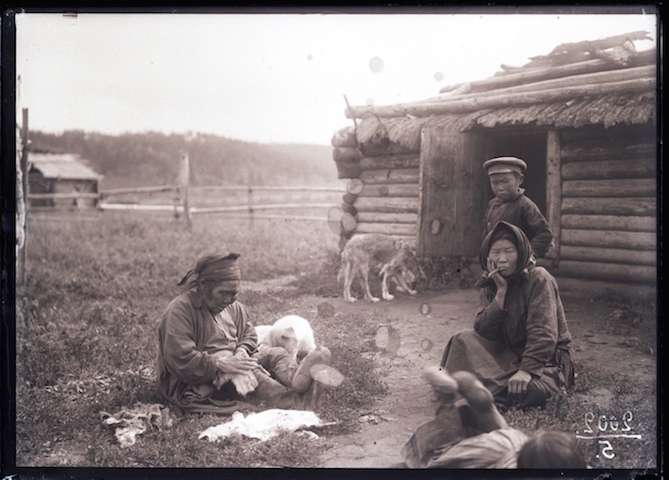Browse Exhibits (3 total)
River Stars Reindeer: Imaging Evenki & Orochen communities of Inner Mongolia & Siberia (Cambridge, United Kingdom, 2015)

One hundred years ago the Russian ethnographer, Sergei Shirokogoroff and his wife Elizabeth, were invited to the snowforests of the Amur River to study the indigenous Evenki and Orochen peoples. In 1929 Cambridge anthropologist and explorer, Ethel John Lindgren, and her soon to be husband Oscar Mamen, went in search of these ‘ little-known tribes’ which were considered to be ‘fast dying out’. Together they amassed a considerable collection of 26,000 culturally and historically important photographs, the majority of which have never been seen, until now.
In collaboration with Evenki and Orochen communities and scholars in Russia and China, the Museum of Anthropology & Archaeology (Unibersity of Cambridge), and the MAE (Kunstkamera), St Petersburg, as caretakers of Shirokogoroff and Lindgren’s photographic collections, are working to share these photographs with the people of Inner Mongolia and Siberia. From the excitement of recognising faces, to the beauty of the reindeer, or the heated debates about what is happening in the photographs, this evocative exhibition is about the reconnection of these communities with their images, their histories, and their stories.
This digital collection is based on the exhibition held at The Museum of Archaeology and Anthropology, Cambridge, United Kingdom, from 23 June – 27 September 2015.
St. Petersburg Geographic Society Exhibition (St. Petersburg, Russia, 2014)

On the 25 September 2014, an exhibition was held in the Great Hall of the headquarters of the Russian Geographical Society, part of the "Meeting of Frontiers: Orochen People in Manchuria through the eyes of Russian and British anthropologists" during the early 20th century.
It portrayed the photographs of two anthropologists whose lives have been inextricably tied to the study of Tungus ethnic groups in Siberia: Shirokogorov Sergei Mikhailovich (1887-1939) and Ethel John Lindgren (1905-1988). Both conducted prolonged field research in Manchuria among different Tungusic peoples, accumulating a unique archive of photographs depicting portraits of informants, scenes of everyday life of the local population, as well as different landscapes. With only 15 years apart, the photographs are not only a dialogue of two anthropologists and their vision of Tungusic culture, but also a dialogue between two different anthropological traditions: Russian and British.
This digital exhibition mirrors that which was on display at the St. Petersburg Geographic Society. In addition, there was a screening of the first documentary film on the Reindeer-Tungus: "The Reindeer Tungus of Manchuria" (60 minutes, black and white, silent), shot by Ethel John Lindgren and her husband, Oscar Mamen, in Manchuria in 1932.
Evenki and Orochen: Ethnic Policies in the People's Republic of China
The People’s Republic of China (PRC) is home to a single supermajority with 92 percent of its 1.3 billion people officially classified as Han (汉族). The remaining 114 million people belong to one of fifty-five other diverse ethnic communities, collectively known as ethnic ‘nationalities’ or minorities (少数民族). These range from a few thousand to several million people who, while concentrated along China’s strategic and resource-rich border regions, are spread across all parts of the country. The Evenki (Chinese: Ewenke) and Orochen (Chinese: Elunchen) are two officially recognised minorities, who according to recent census information have 32,000 and 8,200 members respectively. In fact, their individual histories, internal ethnic composition, and experiences of minority policies remain very little understood. Prior to receiving recognition as distinct ethnicities by the Chinese state, the Evenki and Orochen had no conception of themselves as atomic entities, but rather, were organised into loosely affiliated clans in the characteristic Tungus pattern (Li and Whaley 2004). Correspondingly, historical knowledge of both minorities has been limited to particular clans or clusters of clans in specific regions, and it is only since the Chinese state began settling these clans in the 1950s that they began to see themselves as unified and distinct groups.
In fact, there are three groups in China that share the designation ‘Evenki’, the largest being the Solons who number 27,000 and whose ancestors crossed the Amur, or Heilongjiang River, already in the mid-17th Century. Coming to settle in and around the Hailar region, they assimilated Mongolian cultural traits and practice animal herding. The second Evenki group consists of 6000 people known as the Tungus, who departed the Chita region of Russia around the beginning of the 20th century and, like the Solons, became herders in Inner Mongolia. The third group are the Reindeer Evenki, often referred to in Chinese sources as Yakut, who entered Chinese territory from Yakutia in Russia’s Sakha Republic in the late 1820s (Heyne 1999; Heyne 2007; Kaĭgorodov 1968; Lindgren 1930, 1935, 1936; Nentwig 2003). Numbering just over 280 and the primary research interest of Ethel John Lindgren, their ancestors lived around Lake Baikal as early as 2000b.c. but, by the eighteenth century, some had migrated and crossed the Argun River (Chinese: Erguna) into the forests of the Daxing’anling mountains, straddling the north of today’s Inner Mongolia Autonomous Region and Heilongjiang province. The Orochen share cultural ties with the Reindeer Evenki but have a longer and more complex history in the Daxing’anlingmountains spread across a wide region and structured along clan lines. It is generally assumed that the various clans that now make up the Orochen moved south of the Amur-Heilongjiang in the middle of the 17th century (Shirokogorov 1929; Janhunen 1996). When they first entered the region the were characteristic hunters of the taiga environment, moving frequently between hunting grounds and living in tepee-like tents. However, their migration into the Da Xing’an’liang mountains placed them in a territory that would play a ubiquitous role in subsequent power shifts in East Asia. At the time of the great expansion of the Qing Dynasty towards the end of the 17th century, the area north of the Amur was part of the Qing territory, which was solidifying its control over the whole of China without enough manpower to guard its borders to the north. Consequently, Tsarist Russia seized the opportunity to encroach into Chinese territory along the Amur and, as skirmishes broke out between the two sides, the Orochen were caught up in this upheaval. By all accounts, they were poorly treated by Russian merchants and soldiers alike, and they appear to have sided early on with the Qing (Janhunen 1996). By the 18th-century, the different Orochen clans had been incorporated into the government system of the Qing dynasty, with many skilled hunters and horseman admitted into the Banner system and the remaining placed into five administrative units called lu. These were: Kumarlu, Alilu, Duobuku’erlu, Tuohelu, and Birarlu - based on the different Orochen clans and coinciding with the five major rivers where Orochen hunting grounds were located. During this time they were allowed a certain amount of regional autonomy and prominent shamans retained a degree of authority.
After the founding of the People’s Republic in 1949 the Evenki and Orochen entered a new period of state incorporation in China. Soon the government began to entice communities to leave behind their nomadic lifestyles with promises of housing, healthcare and better food provision. In the 1950s the government constructed houses for the Reindeer Evenki in the village of Qiqian, on the eastern bank of the Erguna. Far from becoming sedentary, they continued their hunting lifestyle, living most of the year in tents transported by reindeer (Kolås and Xie 2015). However, the deteriorating relationship between China and the Soviet Union in the early 1960s had far-reaching implications. Due to growing tension and tightened border control a new settlement named Aoluguya was built in the interior of the Amur River bend, near the town of Mangui. The Reindeer Evenki was relocated there, and for nearly four decades (1965–2003) Aoluguya was the seat of their ‘ethnic township’ (Chinese: minzu xiang). Then the community was again relocated, this time to the ‘new Aoluguya’ near the city of Genhe.
Sedentarisation of the Orochen was complicated by their wider distribution over many different administrative divisions, including in two separate provinces. Early on, the state constructed settlements reflecting people’s practice of subsistence hunting. In 1953, the government carried out its first national census, which identified a total of 2,256 Orochen in all locations. In 1951, the Orochen Autonomous Banner was founded in Inner Mongolia, with Alihe as the capital, which became the seat of the Orochen minority government, though it did not represent those Orochen in Heilongjiang province who fall under a different administrative structure. In Inner Mongolia, the government integrated three administrative areas where the Orochen were living to set up the Autonomous Banner and was demarcated for use by Orochen only, with a population of no more than 800 persons. At the time, the Banner was covered by vast swathes of forest, accounting for 97% of the land of an area of about 60,000 square kilometres, larger than Switzerland and approximately two times the size of Belgium. By 1958, numerous Orochen villages had been built across the northeast and full nomadism had ended, but regular and long-distant hunting remained an integral part of everyday life (Lundberg and Zhou 2009).
Accompanying the sedentarisation of Evenki and Orochen communities was a formal identification process to register ethnic minorities. The Chinese term for ethnic minorities is shaoshu minzu (少数民族), which has traditionally been defined as ‘minority nationalities’. This has its roots in the etymological history of communist China and the Soviet Union, as it derives from Stalin’s definition of ‘nationality’ based on the so-called ‘4 commons: ‘a historically constituted, stable community of people, formed on the basis of a common language, territory, economic life, and psychological makeup manifested in a common culture’. This definition was accepted by the Chinese Communist Party and came to be incorporated into national ethnic policy (Williams 2002, Mackerras 2003). Beginning in the 1950s, the PRC sent out teams of researchers to assess the ‘nationality’ status of groups seeking to apply for recognition. In total sixteen teams went to eat, live and work with members of different ethnicities to identify distinct groups, as well as to train local ethnologists to collect further ethnographic data. In the 1964 census 183 nationalities applied for registration, though the government only recognised 54, later increased to the current 55 (Hansen 1999). Evenki and Orochen communities became inextricably caught up in the identification process. This was formalised at a meeting in Hailar in 1951 between government officials and selected Evenki and Orochen leaders to decide on the classification of northern ‘Tungusic’ groups, though significantly this did not represent all sub-groups and regional communities. Initially, the government proposed they join together as a single minority, though this was rejected by the Orochen representatives who claimed ‘indignity’ in the Daxing’anlingmountains and a distinct cultural lifeworld based on sub-arctic hunting. The result was the recognition of two official groups - the Evenki and the Orochen.
Most Chinese scholars accept Stalin’s definition and it continues to determine much official identifications of minority nationalities, including population and other statistics. In fact, its use is problematic when we consider that the official state definition required all four criteria for a group to qualify as an autonomous ethnic group (Mackerras 2003). However, many ethnic groups did not fit the official classifications: the ten million Manchu in China could not (and still cannot) speak, write or read the Manchu language, though there would be no doubt to assign them official minority nationality status. Similarly the Hui – the Chinese Muslims – are united largely by their religion, but have no particular geographic affiliation, and in fact the majority are Chinese speakers who otherwise differ little from their Han neighbours except their faith. In Inner Mongolia, numerous ethnic Mongolian groups have been incorporated into a single Mongolian ‘minority’, including the numerically significant Buryats.
These discrepancies highlight the role of the minority state has had in constructing ethnic groups and divisions, as well as how ethnic identities are experienced outside the boundaries of the official categories. The case of the Evenki and Orochen is instructive in this regard: while today both are recognised as ethnically distinct, the terms ‘Evenki’ and ‘Orochen’ do not capture the historical complexity of different sub-groups and the cultural breadth of people’s actual lived experiences, both historically and in the present. The Reindeer Evenki, for example, have been subsumed within the broader Evenki category, which is dominated numerically and politically by the southern Evenki populations. This is despite themselves feeling more distinctive given their use of reindeer, and to some extent, more closely related to the northerly Orochen.
The Orochen are similarly recognised as a single minority but in fact are fragmented across a vast geography that has been the product of sedentarisation policies mapped onto existing clan ties. As the Chinese state settled Orochen communities they were incorporated into different provincial governments which fused with local Orochen histories to produce regionally-different experiences of minority policy. One major effect of this is that Orochen in different regions are relatively unaware of their neighbouring communities, something which has an enduring impact on pan-Orochen ethnic identity.
Heyne, F.G. (1999) The Social Significance of the Shaman Amongst the Chinese Reindeer-Evenki. Asian Folklore Studies. Vol. 58. No. 2. pp. 377-395.
- (2007) Notes on Blood Revenge Amongst the Reindeer-Evenki of Manchuria (Northeast China) Asian Folklore Studies. Vol. 66. No. 1 pp. 165-178.
Kajgorodov, A.M. (1968) Evenki v Trechrec'e. Sovetskaja Etnografia (4): 123-31.
Lindgren, E. (1933) Northwest Manchuria and the Reindeer-Tungus. The Geographical Journal. Vol. 75. No. 6. pp. 518-34.
Hansen, M. H. (1999). Lessons in being Chinese: Minority education and ethnic identity in Southwest China, University of Washington Press.
Kolås, Å. and Y. Xie (2015). Reclaiming the Forest: The Ewenki Reindeer Herders of Aoluguya, Berghahn Books.
Li, F. and L. Whaley (2004). The End of Nomadism: Oroqen History, Migration and Current Distribution. Proceedings of the First International Conference on Manchu-Tungus Studies (Bonn, August 28-September 1, 2000): Trends in Tungusic and Siberian linguistics, Otto Harrassowitz Verlag.
Lundberg, M. and Y. Zhou (2009). "Hunting-Prohibition in the Hunters' Autonomous Area: Legal Rights of Oroqen People and the Implementation of Regional National Autonomy Law." International Journal on Minority and Group Rights 16(3): 349-397.
Mackerras, C. (2003). China's ethnic minorities and globalisation, Routledge.
Williams, D. M. (2002). Beyond great walls: environment, identity, and development on the Chinese grasslands of inner Mongolia, Stanford University Press.
Nentwig, I. (2003) Reminiscences About The Reindeer Herders of China. Cultural Survival Quarterly. Vol. 27. No.1. pp. 36-38.
Shirokogoroff, S.M. (1929) Social Organisation of the Northern Tungus. Shanghai: The Commercial Press Limited.
